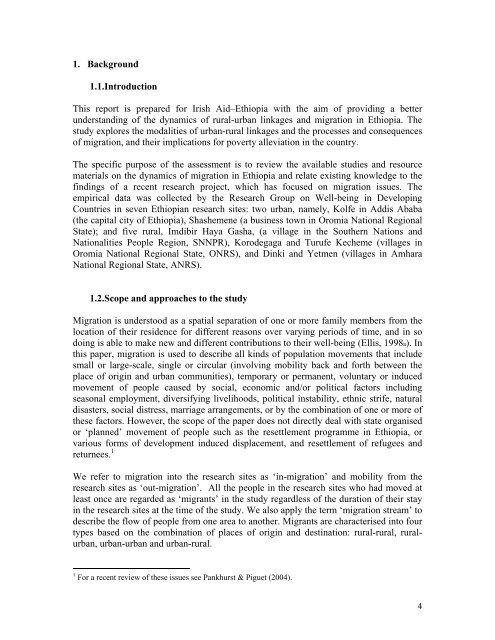Migration and Rural-Urban Linkages in Ethiopia
Migration and Rural-Urban Linkages in Ethiopia - Ethiopian Review
Migration and Rural-Urban Linkages in Ethiopia - Ethiopian Review
You also want an ePaper? Increase the reach of your titles
YUMPU automatically turns print PDFs into web optimized ePapers that Google loves.
1. Background1.1.IntroductionThis report is prepared for Irish Aid–<strong>Ethiopia</strong> with the aim of provid<strong>in</strong>g a betterunderst<strong>and</strong><strong>in</strong>g of the dynamics of rural-urban l<strong>in</strong>kages <strong>and</strong> migration <strong>in</strong> <strong>Ethiopia</strong>. Thestudy explores the modalities of urban-rural l<strong>in</strong>kages <strong>and</strong> the processes <strong>and</strong> consequencesof migration, <strong>and</strong> their implications for poverty alleviation <strong>in</strong> the country.The specific purpose of the assessment is to review the available studies <strong>and</strong> resourcematerials on the dynamics of migration <strong>in</strong> <strong>Ethiopia</strong> <strong>and</strong> relate exist<strong>in</strong>g knowledge to thef<strong>in</strong>d<strong>in</strong>gs of a recent research project, which has focused on migration issues. Theempirical data was collected by the Research Group on Well-be<strong>in</strong>g <strong>in</strong> Develop<strong>in</strong>gCountries <strong>in</strong> seven <strong>Ethiopia</strong>n research sites: two urban, namely, Kolfe <strong>in</strong> Addis Ababa(the capital city of <strong>Ethiopia</strong>), Shashemene (a bus<strong>in</strong>ess town <strong>in</strong> Oromia National RegionalState); <strong>and</strong> five rural, Imdibir Haya Gasha, (a village <strong>in</strong> the Southern Nations <strong>and</strong>Nationalities People Region, SNNPR), Korodegaga <strong>and</strong> Turufe Kecheme (villages <strong>in</strong>Oromia National Regional State, ONRS), <strong>and</strong> D<strong>in</strong>ki <strong>and</strong> Yetmen (villages <strong>in</strong> AmharaNational Regional State, ANRS).1.2.Scope <strong>and</strong> approaches to the study<strong>Migration</strong> is understood as a spatial separation of one or more family members from thelocation of their residence for different reasons over vary<strong>in</strong>g periods of time, <strong>and</strong> <strong>in</strong> sodo<strong>in</strong>g is able to make new <strong>and</strong> different contributions to their well-be<strong>in</strong>g (Ellis, 1998a). Inthis paper, migration is used to describe all k<strong>in</strong>ds of population movements that <strong>in</strong>cludesmall or large-scale, s<strong>in</strong>gle or circular (<strong>in</strong>volv<strong>in</strong>g mobility back <strong>and</strong> forth between theplace of orig<strong>in</strong> <strong>and</strong> urban communities), temporary or permanent, voluntary or <strong>in</strong>ducedmovement of people caused by social, economic <strong>and</strong>/or political factors <strong>in</strong>clud<strong>in</strong>gseasonal employment, diversify<strong>in</strong>g livelihoods, political <strong>in</strong>stability, ethnic strife, naturaldisasters, social distress, marriage arrangements, or by the comb<strong>in</strong>ation of one or more ofthese factors. However, the scope of the paper does not directly deal with state organisedor ‘planned’ movement of people such as the resettlement programme <strong>in</strong> <strong>Ethiopia</strong>, orvarious forms of development <strong>in</strong>duced displacement, <strong>and</strong> resettlement of refugees <strong>and</strong>returnees. 1We refer to migration <strong>in</strong>to the research sites as ‘<strong>in</strong>-migration’ <strong>and</strong> mobility from theresearch sites as ‘out-migration’. All the people <strong>in</strong> the research sites who had moved atleast once are regarded as ‘migrants’ <strong>in</strong> the study regardless of the duration of their stay<strong>in</strong> the research sites at the time of the study. We also apply the term ‘migration stream’ todescribe the flow of people from one area to another. Migrants are characterised <strong>in</strong>to fourtypes based on the comb<strong>in</strong>ation of places of orig<strong>in</strong> <strong>and</strong> dest<strong>in</strong>ation: rural-rural, ruralurban,urban-urban <strong>and</strong> urban-rural.1 For a recent review of these issues see Pankhurst & Piguet (2004).4




![to read the full report [pdf, Amharic] - Ethiopian Review](https://img.yumpu.com/52737829/1/190x245/to-read-the-full-report-pdf-amharic-ethiopian-review.jpg?quality=85)











